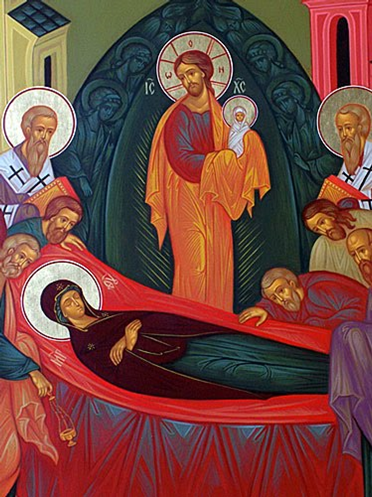Dormition of the Theotokos

On August 15, the Church commemorates the Feast of the Dormition of the Theotokos - the repose (dormition - kimisis in Greek) or "falling-asleep" of the Mother of our Lord and the translation into heaven of the body of the Theotokos. The Feast also commemorates the death, resurrection and glorification of Christ's mother. It proclaims that Mary has been "assumed" by God into the heavenly kingdom of Christ in the fullness of her spiritual and bodily existence. The Church year begins on September 1, and the first Great Feast (one of the twelve Great Feasts) of the year is the Nativity of the Theotokos, making the DORMITION OF THE THEOTOKOS the last great feast of the year. The Church calendar tells us the story of our Salvation in the traditional way, with the climax of the story coming in the middle with the celebration of Pascha. Therefore, the final “scene” in our story of Salvation is the Dormition of Mary, the Mother of God. The Apostles were miraculously summoned to this event, and all were present except Thomas. The Mother of God was then buried. When Thomas arrived a few days later, and desiring to see her one more time, convinced the others to open her tomb. Upon doing so, the Apostles discovered that her body was no longer present. This event is seen as a firstfruits of the resurrection of the faithful that will occur at the Second Coming of Christ. In the Icon of the Feast, we see the Apostles reverencing the body of the Theotokos: St. Paul at her feet; St. Peter at the head with censer in hand. Together with the Apostles are several bishops, some holy women and other members of the church in Jerusalem. The main aspect of the Icon though is the image of Christ in Glory holding the pure soul of Mary in His arms, shown as an infant. Most Holy Theotokos, Save us!
La Dormition de la Mère de Dieu
La Dormition de la Mère de Dieu - célébrée le 15 août - est la commémoration de la mort, entourée des Apôtres, de la résurrection, et de la glorification de Marie la Mère de Dieu. C'est l'une des douze grandes fêtes du calendrier liturgique de l'Église orthodoxe et la dernière du calendrier liturgique (la première étant la Nativité de la Vierge). Il y est proclamé que Marie a été "élevée" par Dieu jusqu'au Royaume céleste du Christ dans la plénitude de son existence physique et spirituelle. Les Apôtres étaient miraculeusement présents à cet événement, à l'exception de Thomas. Il serait arrivé peu de jours après l'enterrement; désirant la voir une dernière fois, il convainc les autres apôtres d'ouvrir la tombe. La tombe ouverte, les apôtres découvrirent que son corps avait disparu. Cet événement est compris comme les prémices de la résurrection des corps, qui aura lieu lors du Second avènement du Christ. Le corps de Marie n'a pas connu la corruption qui suit la mort ; il n'est pas resté dans le tombeau ; Marie ressuscitée a été transportée au ciel par les anges. L’icône de la Dormition montre l’émotion de toute la création devant la mort de Celle qui a porté au monde Celui qui est la Vie. L’icône est construite autour de deux plans qui se touchent : un plan horizontal avec le lit où repose le corps de la Vierge, et un plan vertical avec une mandorle où le Rédempteur tient à côté de son cœur l’âme immaculée de sa mère. L’apôtre Pierre est penché au-dessus du lit en train de se lamenter et agite l’encensoir. Aux pieds de Marie, l’apôtre Paul semble pleurer lui aussi et fait pendant à Pierre. Des évêques et un certains nombre de femmes apparaissant à l'arrière de l'assemblée assistent également aux funérailles de la Mère de Dieu.